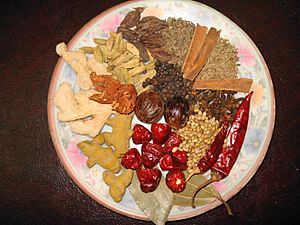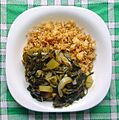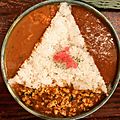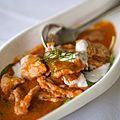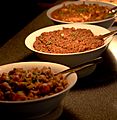Curry facts for kids
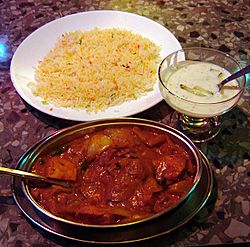
Pilau rice, cucumber rhaita and Chicken Tikka Jalfrezi
|
|
| Region or state | Indian Subcontinent, spread worldwide |
|---|---|
| Main ingredients | Spices, herbs, usually fresh or dried hot peppers/chillies |
Curry is a popular type of dish that first came from the Indian subcontinent. What makes a dish a "curry" is its special mix of spices and herbs. These often include fresh or dried hot chillies. The word "curry" usually means dishes that have a sauce. In southern India, some curry dishes even use leaves from the curry tree for flavor.
Spices are used in many ways in curry. They can be whole or ground into a powder. They can be cooked or raw, and added at different times while cooking. This helps create different tastes. The main spices in most Indian subcontinent curry powders are coriander, cumin, and turmeric. Many other spices can be added depending on the area and what food is being cooked, like fish, lentils, meat, rice, or vegetables.
Curry powder, which you can buy in stores, was mostly created in Western countries in the 1700s. People believe Indian traders first made these spice mixes to sell to British people returning home from India.
Curry dishes can have fish, meat, chicken, or seafood. They can also be made with just vegetables. Many people who choose not to eat meat for ethical or religious reasons enjoy vegetarian curries.
Curries can be either "dry" or "wet." Dry curries are cooked with very little liquid. The liquid evaporates, leaving the food coated with the spice mix. Wet curries have a lot of sauce or gravy. This sauce can be made from yogurt, cream, coconut milk, tomato, or broth.
Contents
What does the word 'curry' mean?
The word "curry" comes from the Tamil word "kari," which means "sauce." This sauce usually has vegetables or meat cooked with spices, with or without gravy. The word "cury" appeared in an English cookbook around 1390. The word "kari" was first described in a Portuguese cookbook in the mid-1600s. This was when the British East India Company traded with Tamil merchants in India. The first English recipe for curry was printed in 1747 by Hannah Glasse.
Where did curry come from?
Scientists have found old clues from 2600 BCE in Mohenjo-daro. These clues suggest that people used tools to grind spices like mustard, fennel, cumin, and tamarind pods to flavor their food. Black pepper comes from South Asia and Southeast Asia. It has been used in Indian cooking since at least 2000 BCE.
Curry dishes came to English cuisine in the 1600s. This happened through Anglo-Indian cooking, where spicy sauces were added to plain cooked meats. Curry was first served in coffee shops in Britain in 1809. It became much more popular in Great Britain in the 1940s and 1970s.
In the 1800s, Indian workers brought curry to the Caribbean islands. They worked there in the British sugar industry. Since the mid-1900s, many types of curries have become popular all over the world. They are now often part of international fusion cuisine, which mixes different food styles.
Different types of curry dishes
Restaurants in Great Britain use many Indian names for popular dishes. Even though the names come from traditional dishes, the recipes are often different. Here are some common names:
- Bhuna – A medium-spicy curry with a thick sauce and some vegetables. The word "bhunna" in Urdu means "to be fried."
- Biryani – A dish with spiced rice and meat cooked together. It is usually served with a vegetable curry sauce.
- Curry – This is the most common name for a meat dish, often chicken or lamb. It has a medium-spicy, brown, gravy-like sauce.
- Dhansak – In curry restaurants, this can be made with lamb or chicken. It often has pineapple, but this is not part of the original dish. The name comes from a Parsi dish of mutton cooked with lentils and vegetables.
- Dupiaza/dopiaza – A medium curry. The name means "double onion" because it uses boiled and fried onions as its main ingredient.
- Jalfrezi – A dish with onion, green chili, and a thick sauce.
- Kofta – Dishes that have meatballs, usually lamb. They can also have vegetable meat-substitutes, often made from ground nuts.
- Korma/kurma – A mild, yellow curry with almond and coconut powder.
- Madras curry – This is known as a hot and slightly sour curry in Indian restaurants.
- Pasanda – In the UK, this is a mild curry sauce made with cream, coconut milk, and almonds or cashews. It is served with lamb, chicken, or king prawns.
- Naga curry – An extremely hot dish with a special savory taste. It is made with the very strong Naga Morich or Bhut Jolokia chili pepper.
- Pathia – A hot curry, similar to a "Madras" but with lemon juice and tomato purée added.
- Phaal – This is often the hottest curry a restaurant can make. It is a new invention and not found in India.
- Roghan josh – A medium-spicy curry, usually made with lamb. It has a deep red sauce, tomatoes, and paprika. It comes from a dish in Kashmir.
- Sambar – A medium-heat, sour curry made with lentils and tamarind.
- Vindaloo – This is usually seen as the classic "hot" restaurant curry. Even hotter versions are sometimes called "tindaloo" and "bindaloo."
The tandoor oven came to Britain in the 1960s. Because of this, tandoori and tikka chicken became very popular dishes. Other dishes have different spice levels. Curries from northern India, like butter chicken, are usually mild. Recipes from southern India tend to be hotter.
What is curry powder?
Curry powder is a mix of spices that can be very different in what they contain. The British created it to make Indian-tasting food at home. In India, a "masala" means a mix of spices. It also refers to a thick, pasty sauce made from spices with ghee (clarified butter), butter, or coconut milk.
Most curry powders sold in Britain, the U.S., and Canada use a lot of ground turmeric. This makes the sauce very yellow. Other common ingredients in these Western yellow curry powders are coriander, cumin, fenugreek, mustard, chili, black pepper, and salt.
However, curry powders and pastes made and eaten in India are very diverse. Some are red, some yellow, some brown. Some have only five spices, while others have 20 or more! Besides the spices mentioned, Indian curry powders often include allspice, white pepper, ground ginger, cinnamon, cloves, nutmeg, bay leaves, and cardamom.
Related pages
Images for kids
-
Butter chicken served in an Indian restaurant
-
Red roast duck curry (hot and spicy) from Thailand
-
Rice and Chenopodium album leaf curry with onions and potatoes; a vegetarian curry
-
Homemade chicken tikka masala
-
Hannah Glasse's recipe for curry, first published in her 1747 book The Art of Cookery Made Plain and Easy. It is the first known anglicised form of kaṟi. (The recipe uses the Long s, "ſ").
-
Filipino chicken curry, a variant of the native ginataang manok with curry powder
-
Curry chicken from Pakistan
-
yoghurt and gram flour curry
See also
 In Spanish: Curry para niños
In Spanish: Curry para niños


